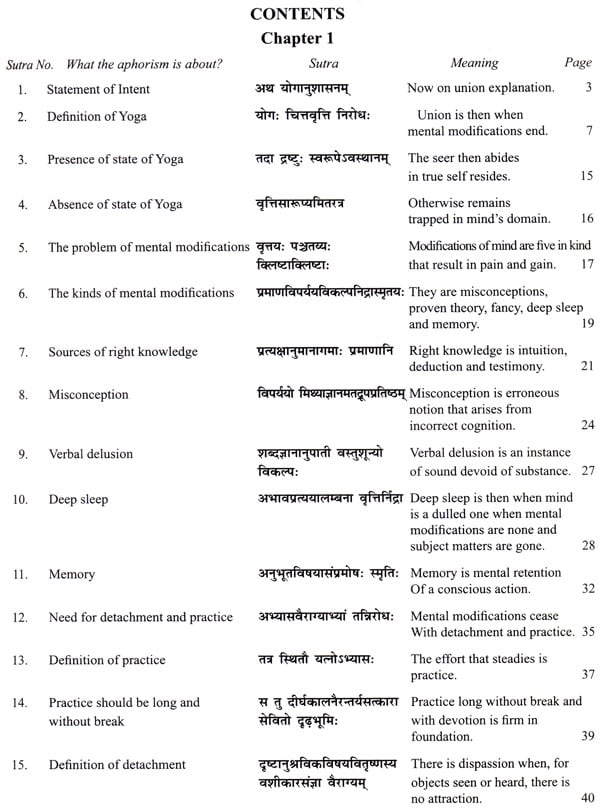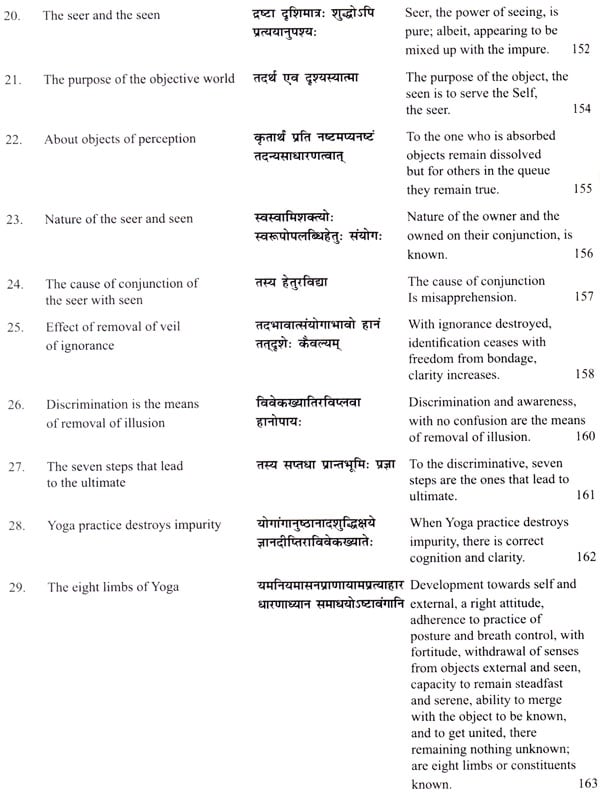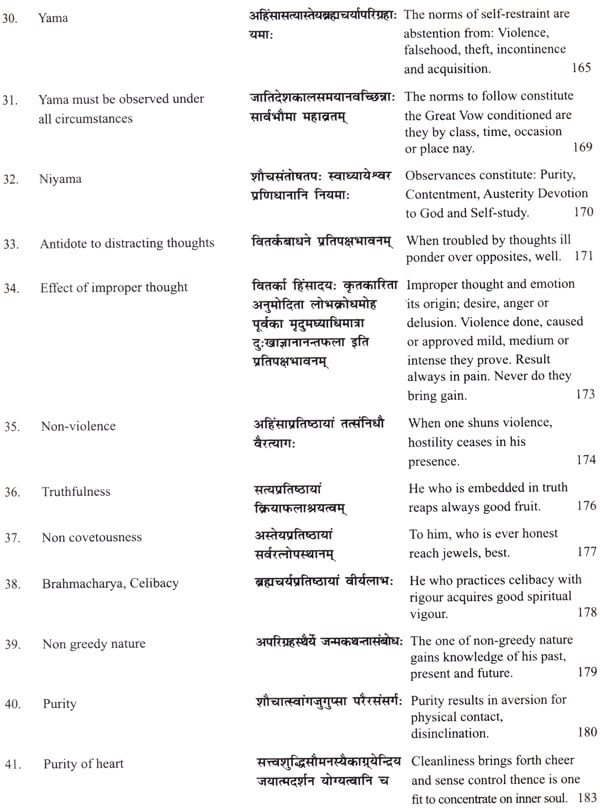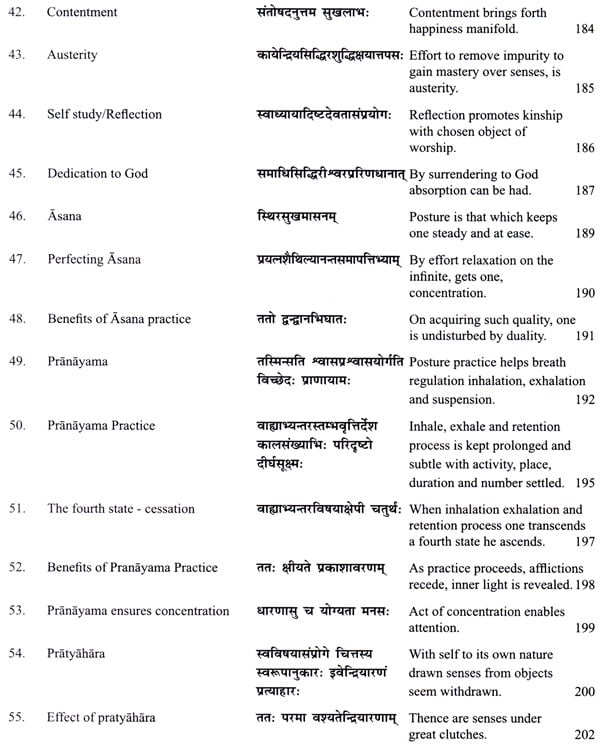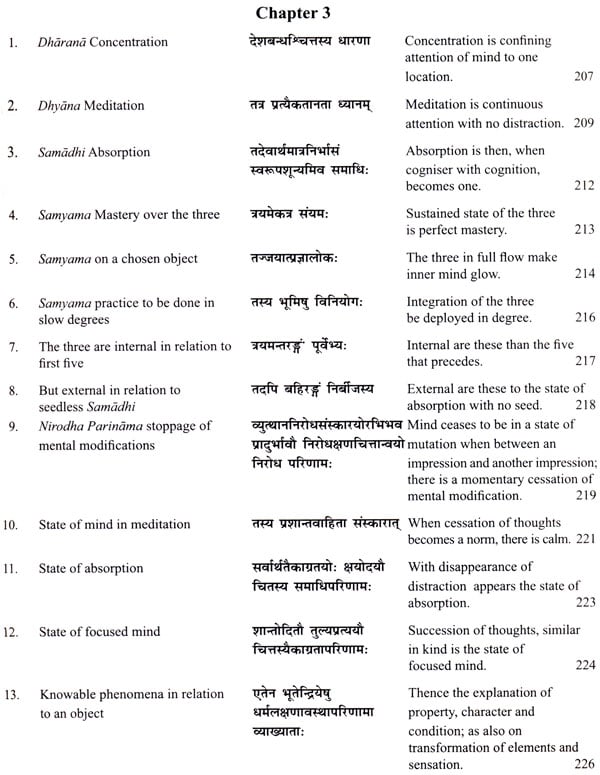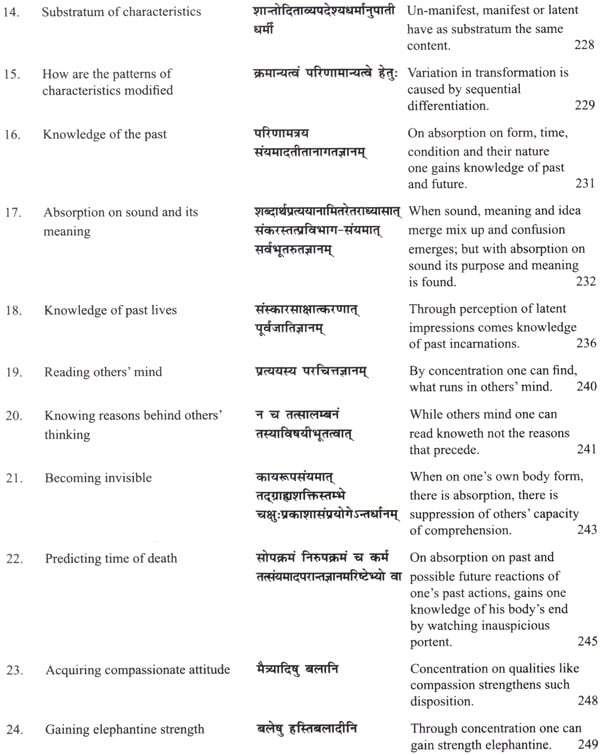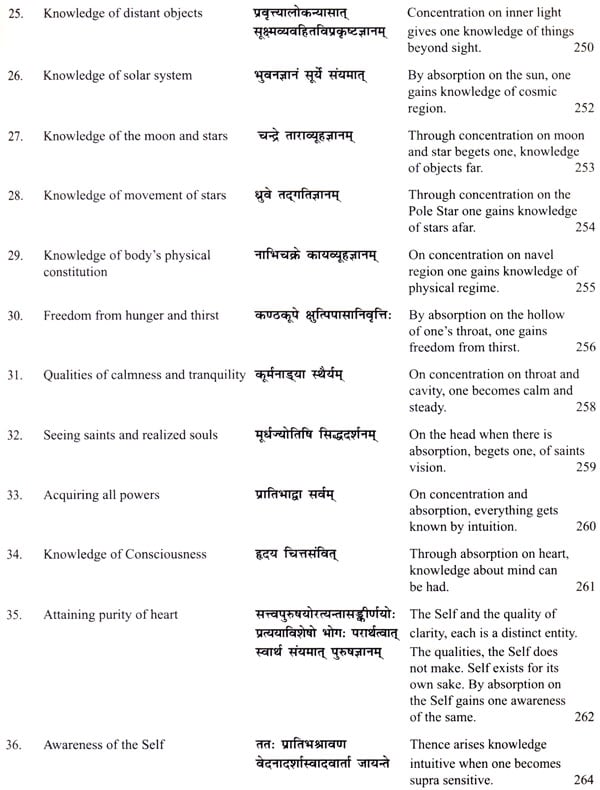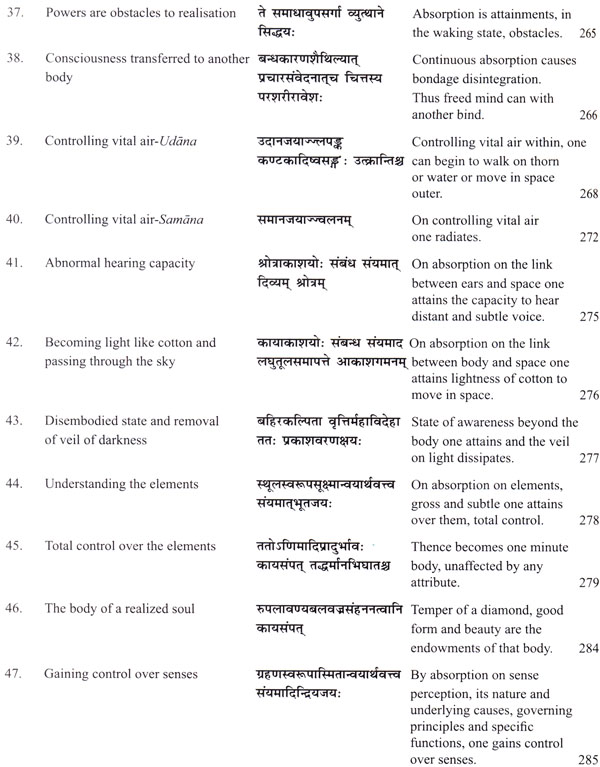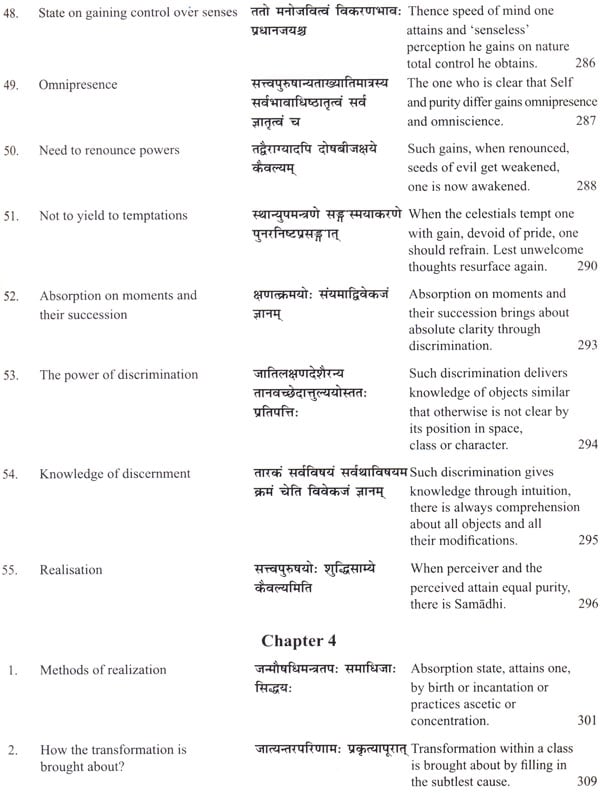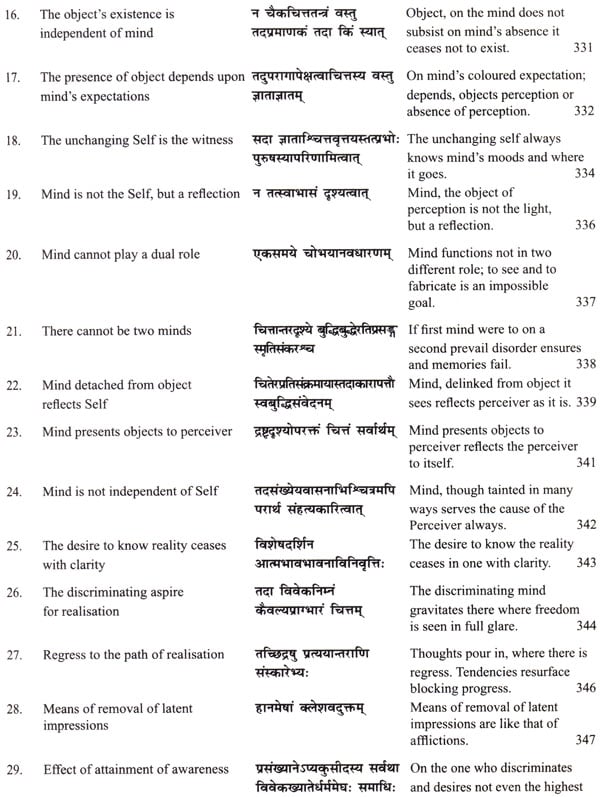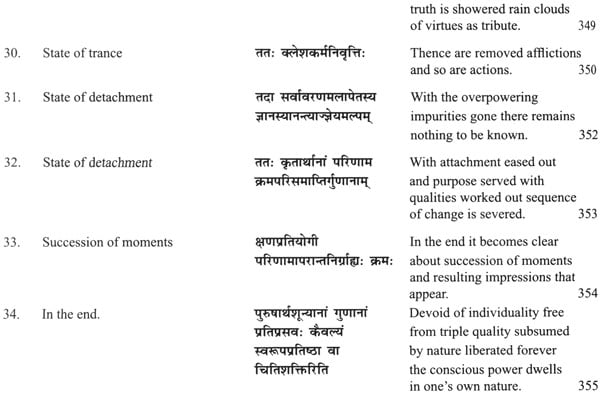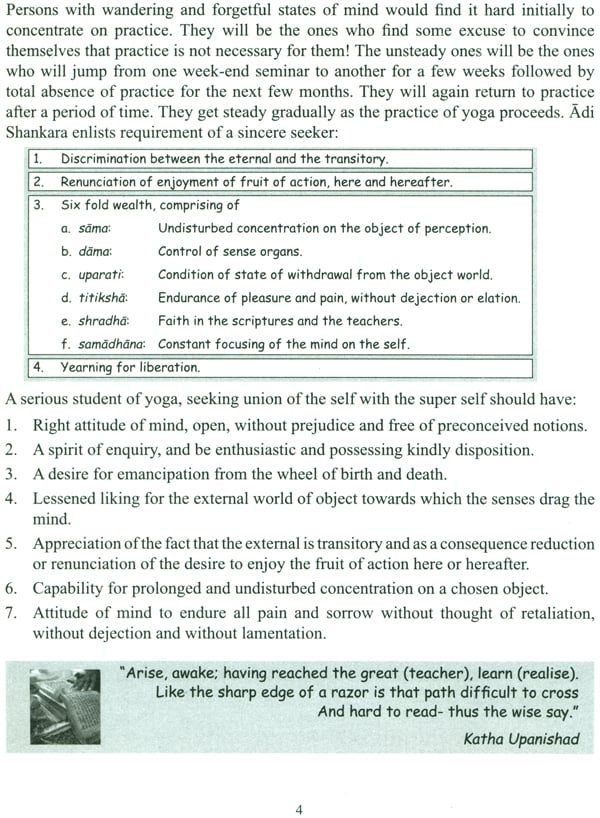
195 Yoga Sutra from Astanga Yoga
Book Specification
| Item Code: | NAI452 |
| Author: | S.V. Subramanyam |
| Publisher: | PUSTAK MAHAL |
| Language: | English |
| Edition: | 2010 |
| ISBN: | 9788122311532 |
| Pages: | 397 |
| Cover: | Paperback |
| Other Details | 9 inch X 7 inch |
| Weight | 690 gm |
Book Description
Presents all the 195 Yoga Sutras professed by the legendary Maharishi PATANJALI. He affirmed that Yoga is not only limited to asanas, but also - aims at outer and inner purification; control and balance of the self; meditation and complete absorption. And finally union with the Self.
Contains 4 Chapters on Samadhi, Sadhana, Vibhuti and Kaivalya. Comprises all the 8 limbs of Ashtanga Yoga: 5 external and 3 internal - Yama, Niyama, Asana, Pranayama, Pratyahara, Dharana, Dhyana, and Samadhi.
The book fully utilises available technology to aid elaboration of the commentary on Yoga Sutras which are admittedly terse. Charts and tables as well as graphs and pictures adore the book practically on every page so that the reader finds it helpful to enhance his understanding. Stories and quotations from the spiritual greats are added to widen comprehension. This is a book that is truly unique in its presentation that would find ready acceptance by Yoga teachers and students alike all over the world. All those students and teachers of Yogasanas who wish to go beyond asanas and aim at avoidance of mental modifications and the resultant stressful life would find this book a boon.
Prof. S V Subramanyam is a multifaceted personality, a technocrat entrepreneur, professor of management science, management consultant, software exporter and an eloquent speaker, ail rolled in one. His spiritual pursuits and Yoga training stretch over three decades. A keen student of Vedanta and a Yoga practitioner, he has several publications on the anvil on Upanishads, Narada Bhakti Sutras and commentaries on Adi Sankara's works like Bhaja Govindam and Sadhana Panchakam.
Prof. Subramanyam has degrees in Mathematics, Engineering and Management Science. He had his higher education in Germany and was a Carl Duisburg Gescellshaft scholar. His post graduate education and training and his subsequent experience in German industry as well as his Vedantic spirit of inquiry and reasoning enables him to bring forth precision and thoroughness to any subject that he teaches or writes about.
For the modem day computer oriented individuals world wide, who are keen on learning Yoga and going beyond asanas to enhance understanding of spiritual science and increase awareness, Prof. Subramanyam uses tables, diagrams, charts extensively besides stories and quotations from the great spiritual texts in his commentaries on Patanjali Yoga Sutras.
Bertrand Russell in his Impact of Science on Society voiced his concern decades back when he said: "Broadly speaking we are in the midst of a race between human skill as to means and human folly as to ends ..... It follows that, unless men increase in wisdom as much as in knowledge, increase of knowledge will be increase of sorrow." Today we are witnessing what was foretold by Bertrand Russell: There is increased knowledge, but alas there is also increased sorrow. The violence and hatred that is widespread indicates the increased ignorance, aversion and attachment and its consequences that Sage Patanjali so eloquently explained, when he extolled the seeker to free himself from the bondage. The clinical precision with which the great sage dissects this disease of ignorance is indeed astounding.
If there is one text that is regularly being read, commented upon and whose instructions are sought to be practised and which is yet not a religious text, it is Patanjali Yoga Sutras. If there is yet one text that is truly internationally being read in the last few decades and its essence is found to be most appropriate to be understood and adhered to, it is Patanjali Yoga Sutras. If there is one text that is found in every library of universities world over and referred to by students of Theology, Philosophy and Psychology it is Patanjali Yoga Sutras.
The subject of mind and matter interests the physicist, theologist, psychologist, spiritualist and the philosopher world over, especially today, when modem science is moving ever so closer to a stage of concurring with spiritualists and finding less area of conflicts.
There is a big list of reference materials and commentaries available on the Yoga Sutras. One more book on Patanjali Yoga? I wasn't sure I should attempt, until I realized that a whole new FAQ generation of youngsters are up there used to richly illustrated manuals and learning through question answer and user friendly format. This generation also has the added advantage of computers at their disposal as also tools that enable pictorial presentation. This book fully utilizes available technology to ensure easy readability.
I realize too that it is a difficult task to raise right questions and provide right answers on a subject like Yoga Sutras. Even then I decided to attempt for I am aware that my book will be used as a primer by the seeker. He will then graduate to reading commentaries by learned and noble souls of which there is no dearth, until he reaches a stage when he will neither have questions to ask nor answers to seek.
I have carefully selected quotations from the sayings of the enlightened ones as a testimony for the seeker to refer to. An aphorism is short and terse and leaves it to the reader to infer more. I have attempted a similar English aphorism to enable English speaking readers to benefit by.
There is an old saying in Sanskrit, "Wisdom begins where word ends". Any attempt therefore to describe truth in words is bound to fail. To go a step further and attempt at illustrating spiritual messages in tables, charts and diagrams is nothing short of blasphemy! I have dared to do so earnestness to be of help to the spiritual seekers seeking clarity in the rather terse verses. My attempt is to lead the seekers to the doorsteps of enlightened souls who are ever ready to guide sincere seekers.
It is my endeavour to
Make Yogic wisdom available to a wider audience.
Enhance understanding of the Eternal Truth.
Improve readability of the admittedly terse verses.
Enable a quicker understanding of seemingly complicated logic.
I do hope that this book will be well received by the spiritual seekers.
1. What is Yoga?
The word Yoga is derived from the Sanskrit root "yuj' meaning to bind, join, attach and yoke, to direct and concentrate one's attention on, to use and apply. It also means union or communion. It is the true union of our will with the will of God.
2. Is Yoga a means or an end?
It is both. Yoga is the process of taking us back home to our un-obscured true nature. Hence it is a means. Yoga is a state of Union. Hence it is the end.
3. Is Yoga a Science?
Yoga is a science. It is not a vague, dreamy drifting or imagining topic. It is an applied science, a systematized collection of laws applied to bring about a definite end. It takes up the laws of psychology, applicable to the unfolding of the whole consciousness of man on every plane, in every world, and applies those rationally in a particular case. This rational application of the laws of unfolding consciousness acts exactly on the same principles that you see applied around you every day in other departments of science.
4. Is Yoga a religion? Is Yoga Hinduism?
No. Yoga has nothing to do with religion. It is a systematic method of understanding one's true self. Yoga accepts that God as a special person can be used by the seeker in seeking liberation. Yoga is not Hinduism, as it is commonly known as.
5. Is Yoga a philosophy?
No, it is not, in the sense of being a hypothesis. Instead it embodies mostly a practical do it yourself type of instructions.
6. Is Yoga metaphysical?
No. It does not bother about distant questions about past lives, heaven and hell or God or Satan. Yoga is concerned with the present. With the 'Now', with the current problem caused by ignorance, called mind. It gives practical ways to avoid mental modifications so that perception becomes clear, so that one obtains freedom from bonding duality.
7. What is Patanjali Yoga about?
Patanjali's Yoga is essentially related to the mind and its modifications. It deals with the training of the mind to achieve oneness with the Self. Incidental to this objective are the acquisition of siddhis or powers
8. What is the aim of Patanjali Yoga?
The aim of Patanjali Yoga is to set man free from the cage of matter, thus removing his ignorance. Mind is the highest form of matter and man freed from this dragnet of Chitta or Ahankara (mind or ego) becomes a pure being. The mind or Chitta is said to operate at two levels; intellectual and emotional. The aim is liberation.
9. Is Patanjali Yoga and Hatha Yoga same?
Some of the eight aspects (Ashtanga) like Asana and Pranayama that Patanjali prescribes as part of the steps towards spiritual progress, constitute a very important part of Patanjali Yoga Sutras. These parts are so important that a whole branch of specialized knowledge has sprung up out of these two important aspects. That is what is now referred to as Hatha Yoga.
10. What do we know about Patanjali?
He lived a few millenniums before Gautam Buddha, and was a great philosopher. His best known work is Yoga Sutras or Aphorisms on Yoga. The path outlined is called Raja Yoga or the sovereign path. It is so called because of the regal, noble method by which the self is united with the over self.
11. Is Patanjali the originator of Yoga?
Patanjali was not the author or originator of Yoga. He has only compiled and reformulated what was already orally given down the generations for centuries. He was the first to reduce the teachings to writing for the use of students and rightly so he is regarded as the founder of Raja Yoga school.
12. Is Yoga sutras a sermon?
No. It is no preaching either. It is just a set of principles and dictums which when practised and followed will lead the aspirant to the state of Union.
13. What is "Sutra'?
Sutra means thread. Sutra in this context could be interpreted as a terse link or thread of essential points. These "threads" are extremely terse, stating concisely, and often concisely and precisely, essential points or techniques.
Originally these teachings were oral and were explained and interpreted by commentaries from a teacher guiding the student. Sutra (aphorism) enshrines, in a few words, vast expanses of meaning, vast depths of fundamental significance.
The following Sanskrit verse defines a sutra:
Alpaksharama samdigdhe saravat vishvato mukham,
Asto Bhamanavadhyam cha sutram sutra vido viduhu.
A sutra should be:
i. Concise, consisting of minimum number of letters.
ii. Clear, without doubt with regard to the meaning.
iii. Convey the essence of an Upanishadic Statement.
iv. Multi-faceted. Reflect all aspects of the subject.
v. Without glorifications
vi. Faultless (There should be no defects in the words and meanings).
14. In which language were the Sutras written?
The Yoga Sutras of Patanjali were originally written in Sanskrit which is an Indo-European language. Sankrit is the oldest of the Indo-European languages still in active use.
15. Which are the early commentaries written on Patanjali Yoga?
i. Rajamartandavritti of Bhojadeva
ii. Yogasutrapradipika of Bhavaganesha
iii. Yogasutravritti of Nagojibhatta
iv. Yogasiddhantacharika of Narayanathirtha
v. Yogasudhakara of Sadasivabrahmendra
In recent times the commentaries of Swami Vivekananda and Swami Lahari Mahasaya are from amongst the best.
16. A final question, how should one proceed with the study?
Remember Lord Buddha's "Four Reliances":
i. Rely on the message of the teacher, not on his personality,
ii. Rely on the meaning, not just on the words,
iii. Rely on the real meaning, not on the provisional one,
iv. Rely on your wisdom mind, not on your ordinary judgemental mind.
